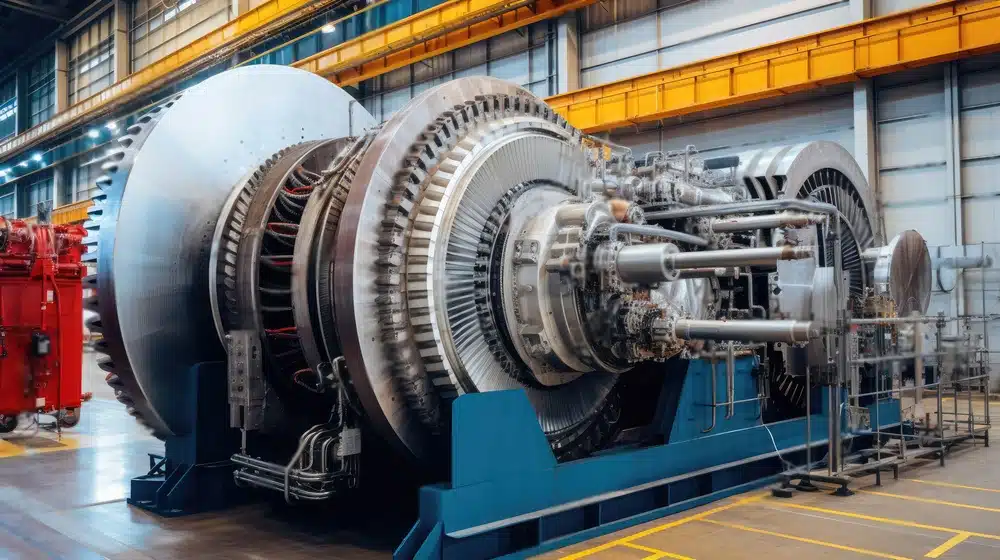What Is a Steam Turbine, What Are Its Types and How Does It Work?
Comments Off on What Is a Steam Turbine, What Are Its Types and How Does It Work?In the world of power generation, few inventions have been as pivotal as the Steam Turbine. These machines are the workhorses behind many industrial and power plants, converting the energy stored in steam into mechanical work. Let’s delve into the depths of Steam Turbines: their types, functions, and the captivating science behind their operation.
What Is A Steam Turbine?
The steam turbine is a machine that can extract thermal energy from steam and convert it into rotary motions. It is classified as a type of heat engine.
Charles Parsons invented the modern steam turbine in 1884, and it is guided by thermodynamic efficiency principles, focusing on the various stages of steam expansion.
Through comprehensive analysis, simulation, and iterative improvements, Product Engineering Services continuously drive the evolution of steam turbine technology, fostering advancements that propel the industry toward greater efficiency and sustainability.
How Steam Turbines Function?
The steam turbine has evolved into an important component in energy generation. As previously stated, the steam turbine converts steam energy into rotary motion. This is then coupled to a generator and converted into electricity.
Steam turbines are used in critical energy generation processes such as thermal power plants and district cooling schemes.
The Steam Turbine Market Report by Global News Wire forecasts a compound annual growth rate (CAGR) of 4.41% for this market from 2022 to 2026, indicating the prevalence of this type of energy generation.
How Does a Steam Turbine Work?
- A heat source is used by the steam turbine to warm up water and convert it to steam. These heat sources range from natural gas to coal to nuclear or solar power.
- This process causes water molecules to expand.
- Steam is then passed through the turbine’s blades, which rotate and convert the thermal energy of steam into kinetic energy. The blades have the ability to control the speed, direction, and pressure of the steam. Following a structure that only makes small increments gradually, turbines can reduce steam pressure and thus improve electrical output and efficiencies.
- The steam turbine is linked to a generator, which generates an electric current.
Steam Turbine Efficiency
In general, turbine efficiency refers to the ratio of electrical output achieved in comparison to the required heat source input. In an era of rising heat source prices (such as natural gas) and a greater emphasis on sustainability, the efficiency of steam turbines cannot be overstated.
In short, higher turbine efficiency lowers operational costs while also having a lower environmental impact. Computer Aided Engineering (CAE) plays a pivotal role in the optimization and design refinement of steam turbines, enhancing their efficiency and performance.
What Are The Types Of Steam Turbines
Steam turbines can be categorized into various types based on different criteria. One primary classification is based on whether they are condensing or non-condensing turbines:
– Condensing Vs. Non Condensing Turbines
Condensing Steam Turbines:
These turbines operate at low pressures, allowing the steam to expand fully within the turbine. They exhaust steam to a condenser, where the steam is condensed back into water. The condensed water is then pumped back to the boiler, completing the cycle. Condensing turbines are typically more efficient than non-condensing turbines because they utilize the entire pressure drop in the steam.
Non-Condensing Steam Turbines:
Non-condensing steam turbines, also known as back-pressure turbines, are a type of steam turbine used to generate power. Unlike condensing turbines, which utilize both high-pressure and low-pressure steam and then condense the steam to water, non-condensing turbines exhaust steam at a specific pressure, maintaining a higher pressure than a condensing turbine.
Each type has its advantages and is suited for specific applications based on the required output, pressure levels, and efficiency considerations.
How Does A Steam Turbine Get Energy From Steam?
A steam turbine works by heating water to extremely high temperatures and then converting it to steam using a heat source such as gas, coal, nuclear, or solar. As the steam flows past the spinning blades of a turbine, it expands and cools. In the rotating turbine’s blades, the potential energy of the steam is thus converted into kinetic energy. Because steam turbines generate rotary motion, they are ideal for driving electrical generators that generate electricity. The turbines are linked to a generator by an axle, which generates energy via a magnetic field that generates an electric current.
Steam turbines stand as the pinnacle of power generation in numerous industries, and their efficiency relies heavily on meticulous design and engineering. Mechanical Engineering Consultants specializing in steam turbines play an instrumental role in optimizing their performance.
How Do the Turbine’s Blades Work?
The turbine blades are perhaps second in importance after steam. As a result, it is preferable to become acquainted with their operation, as they perform the majority of the work of steam turbines.
The blades of a turbine are intended to control the speed, direction, and pressure of steam as it passes through the turbine. For large-scale turbines, dozens of blades are typically attached to the rotor in different sets. Each set of blades contributes to the extraction of energy from the steam while also maintaining optimal pressure levels.
Because of this multi-stage approach, the turbine blades reduce the pressure of the steam in very small increments during each stage. This, in turn, reduces the forces on them and significantly improves the turbine’s overall output.
Technosoft Engineering stands out among Engineering Services Providers for its commitment to innovation and excellence. With a diverse portfolio and a customer-centric approach, Technosoft Engineering delivers cutting-edge solutions across industries.


